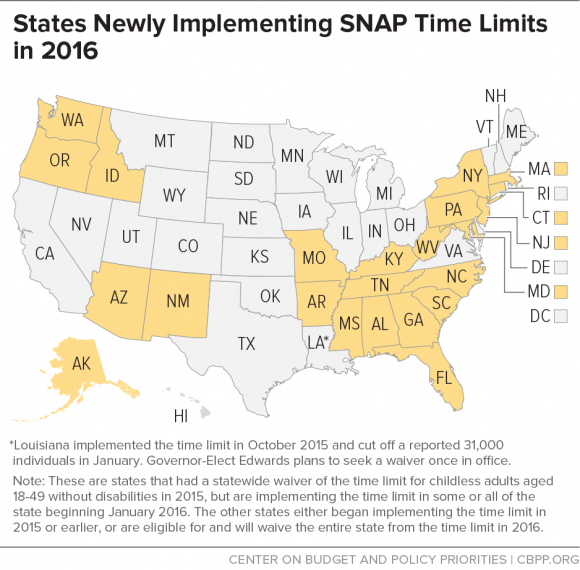Up to 1 million people may be cut off from the federal food stamp program over the course of 2016, according to a liberal think tank in Washington, D.C.
According to the Center on Budget and Policy Priorities, between 500,000 and 1 million people will be cut off from the Supplemental Nutrition Assistance Program benefits as states return to a new limit originally part of the 1996 Welfare Reform Law.
The new limit, which will be in effect in more than 40 states throughout the year, imposes a three-month cap on SNAP benefits for unemployed adults aged 18 to 49 who aren’t disabled or raising children.
That limit “will cause serious hardship among many,” the group said. USDA data show that those likely to be cut off by the three-month limit have an average monthly income of approximately 17 percent of the poverty line, about $2,000 per year for a household of one in 2015, and typically qualify for no other income support.
Many states have been able to qualify for statewide waivers to suspend the three-month limit. But this year, 23 new states, including New Jersey, North Carolina, Georgia and Florida, will have the benefit limit back in effect for the first time since before the Great Recession because of decreasing statewide unemployment levels unless the specific adults in the demographic work at least 20 hours per week.

The problem centers around employment, the group says, as many of those set to be cut off from the benefits struggle to find employment even in good economic times because of limited eduction and skills and slim job prospects where they live. Cutting off this food assistance to them then “doesn’t enable them to find employment or secure more hours of work,” it argued.
Even so, many of the states that will see these new limits provide little work opportunities or job training to those who need it the most. The three-month limit also rules out an individual who is least working half-time (but not the required 20-hour week minimum), participating in qualifying work or training program activities for at least 20 hours a week or doing workfare.
“A person who wants to work but is unable to find a job, and is willing to participate in job training but has no opportunity to do so, loses all of his or her SNAP benefits at the three-month point,” the group argued.
The Center on Budget and Policy Priorities suggested that Congress increase the time limit from three to six months because the typical duration of state unemployment benefits is six months.
According to the Food Research Action Center, SNAP participation averaged 45.5 million people in September 2015, a decrease of almost 1.1 million compared with September 2014.
Read the full analysis by the group here.

